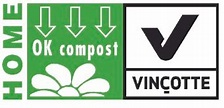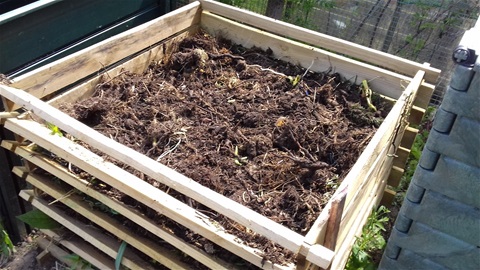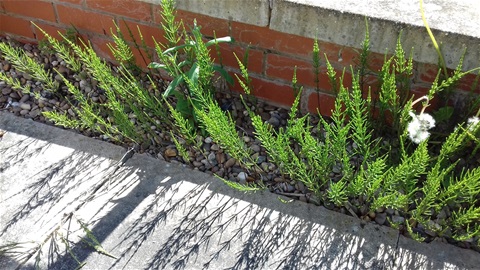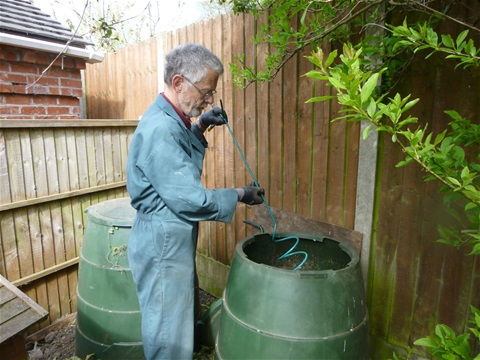Aeration
Aeration is necessary to provide the composting microbes and larger creatures with the oxygen necessary to convert the organic matter into compost and to achieve the temperatures
necessary for the more rapid decomposition of hot aerobic composting.
If the material is not aerated composting will still happen but will take longer, a year or 18 months in some cases, and may become anaerobic. Aeration by turning
the composting material will involve extra work but I believe it is worth it.
If using pallet or New Zealand bins without a front, or where the front panels can be easily removed, the material can be turned from one bin to the next using a garden
fork. However, there are other techniques and bins which avoid the need to turn the contents and as some of these are applicable to the entry level Dalek bin.
1. Building air into the
bin
Mount the bin or pile on an old pallet, this will need replacing as it rots but is easily checked when the bin is emptied, or build a base out of good quality wood about 3-6 inches off
the ground to allow access of air into the base. The slats need to be spaced to allow entry of air but sufficiently close together to prevent the entry of rats and other vermin.
- Aeration via the base layer
Start the composting
by creating a base layer of twigs or small branches from pruning shrubs, brassica stalks etc as a base level to allow air to flow up into the compost. This base layer will not rot down as quickly as the rest of the material and may make it difficult
to empty the bin using the hatch but if this is a problem a Dalek type composter can be knocked over or lifted of the compost when harvesting.
Some add more twigs and scatter them throughout the pile to assist
in aeration but this approach is only applicable if the contents are not to be turned as the sticks make it difficult to makes it more difficult to turn the pile using a fork. Another source suggests that if building a heap or pile, rather
than filling a bin, long sticks could be laid horizontally to crisscross the heap at different levels with hand holds protruding from the pile. As the heap matures the ends of the of the sticks can be turned, lifted and shaken to help aerate
the pile .
- Aeration by browns and bulking agent
At home with a small garden and a steady supply of food waste (nitrogen rich greens) you may opt for a system whereby a kitchen caddy of material is added to the bin every few
days with cardboard or shredded computer paper as the main source of browns. If this is the case air spaces can be built into the heap by adding egg boxes, the cardboard tubes from toilet and kitchen newspaper and crumpled corrugated
cardboard. The addition of a bulking agent. such as woodchip. absorbs water from the food waste and helps maintain the air spaces.
Hotbin advise that in their bin the correct use of a buking agent, such as partially composted woodchip, will
provide and maintain sufficient air spaces for the bin to work effectively. This passive aeration occurs where rising hot air pulls cold air into the heap.
2. Aeration systems
Some of the more expensive bins, such as the Aerobin 400, have a central aeration system which is said to do away with the need to turn the compost. Home composters can create their own aeration tube by drilling holes in plastic downpipe
and placing this in the centre of the bin as soon sufficient material has been added to keep it vertical added.
3. No-turn pallet bin
It is possible to make compost in
a traditional bin using a good combination of green and brown layers without turning and still reach a temperature approaching 80°C. Shewell-Cooper described one such a system in 1972 and more details are given at http://www.carryoncomposting.com/443725799
4. Turning the contents
In order to create finished compost in a short time and to kill seeds and perennial weeds hot composting is required with
the contents of the bin being turned regularly during the initial stages. This can be at fixed times or every time the bin temperature drops below 40°C (or about 100° F)
Hand turning using a garden fork (bin) or pitchfork (heap)
can be used to home compost in a heap, New Zealand box or pallet bin particularly if the material is being transferred to an empty adjacent bin. It is easiest to move the material from one bin to another.
- Windrows
- In
a large garden windrows may be used to compost. Shredded mixed garden waste, such as grass cuttings, pruning and leaves. The windrows are turned on a regular basis to aerate the content with the outer layers binge moved to form the core of
the new windrow with the material from the centre of the established windrow being placed round it.
- Cool Composting
If using the slower cool compost approach adding a mixture of brown and green materials to the bin weekly
as they become available requires less effort but may not kill weeds. Under this type of composting the organic material at the bottom of the bin is ready for use after about a year while the top layers always consist of relative fresh waste. The material
is often not turned, and harvesting is through a hatch at the bottom of the bin. Some composters, usually those with several bins, do turn the do aerate the material by lifting the bin off the compost and refilling it.
Alternatively,
a compost aerator tool can be used. This usually consist of a metal rod handle with some hinged metal arms with teeth on the end. This is plunged into the compost and the teeth will open out as it is pulled out and create air
pockets inside the compost. A second type have a large corkscrew on the end which is turned into the compost. There are photos on the above webpage
If using a compost tumbler, the material is turned
and aerated by turning the whole drum it also helps to control the moisture content of the material to prevent the compaction that may occur in wet material. The effectiveness of this type of compost bin at aerating the material varies with the
shape of the bin, the shape of any internal bars to break up lumps, the moisture content and the weight of the bin when filled to working capacity.
Further information can be found at http://www.carryoncomposting.com/443725799



